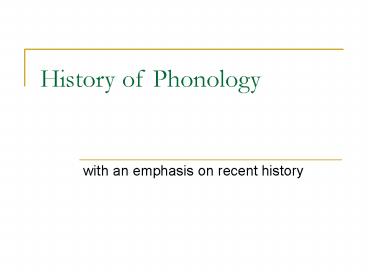History of Phonology - PowerPoint PPT Presentation
Title:
History of Phonology
Description:
Development of Phonetics are a special branch of linguistics ... of stress, Chomsky and Halle used numeral values for stress features: [1 stress] ... – PowerPoint PPT presentation
Number of Views:709
Avg rating:3.0/5.0
Title: History of Phonology
1
History of Phonology
- with an emphasis on recent history
2
1900-1930
- Development of Phonetics are a special branch of
linguistics - Unlike historical linguistics, also concerned
with sounds through its preoccupation with sound
change, phonetics was firmly rooted in synchronic
analysis - Articulatory phonetics
- Acoustic phonetics
3
new tools
- spectrograph
- X-ray photos (and films)
- sound recordings
4
Phonology
- Off-shoot of phonetics
- Strictly devoted to those aspects of sound
structure which are linguistically relevant - E.g. pitch differences related to tone or accent
are phonologically important, pitch differences
related to sex are not - First International Congress of Linguists in The
Hague in 1928 is often viewed as the beginning of
phonology, set off by
5
Prague school
- definition of phoneme
- importance of binary oppositions
- marked vs unmarked member of pair
- neutralization
- languages are systems you cant take out one
thing and study it separately that way you lose
information about various contrasts within the
language
6
Prince Nikolay Sergeyevich Trubetzkoy 1890-1938
7
Roman Jakobson1896-1982
8
Jakobsons accomplishments
- wide-ranging scholar
- worked on Russian case, phonological theory,
poetics, and numerous other topics - introduced the Prague school to the USA
- integrated work on language acquisition and
language loss by aphasia in linguistic theory
9
Generative phonology
- Morris Halle and Noam Chomsky started working on
phonology in the 1950s - Culminating in The Sound Pattern of English (1968)
10
Morris Halle
11
Morris Halle, continued
- student of Roman Jakobson
- likewise of Russian (actually, Latvian) descent
- worked primarily on Slavic and English
- in his The Sound Pattern of Russian, Halle
attacked the classical phoneme - with Chomsky, developed generative phonology
(1956-1968 after 1968 Chomsky stopped doing
phonology)
12
The Sound Pattern of English 1968
- Authors Chomsky and Halle
- Should have been Halle and Chomsky
- Important for its formalization of phonological
representations, rules, and its methodology - Discusses many major issues in the phonology of
English, including phonotactics, phonological
rules, and stress assignment in underived,
derived and compound words
13
Segments
- defined as a bundle of features
- e.g. feature-1
- feature-2 -
- feature-3
- feature-4 -
- etc.
- Features have a standard phonetic
interpretation, in terms of articulation
(Jakobson had proposed an acoustic
interpretation)
14
One exception to binary features
- To capture four levels of stress, Chomsky and
Halle used numeral values for stress features 1
stress, 2 stress, 3 stress and 4 stress - So features, in SPE, come in 2 types
- boolean valued features (/-)
- numerically valued features
15
Rules
- context-sensitive rules
- A ? B / C __ D
- however, not involving whole segments, but
features, or sets of features - many new notational devices were introduced, to
formulate rules a notation, curly brace
notation, etc.
16
Methodology
- economy basic principle
- feature-counting evaluation metric
- highly abstract underlying forms
- complex derivations, involving the phonological
cycle - phonotactics done by rule
- synchronic analysis became a mirror of diachronic
analysis in SPE
17
E.g.
- Dutch has no diphtongs before /r/
- Historical account diphtongization never took
place before /r/ - Possible synchronic account assume diphtongs are
underlying monophongs, and diphtongize them
unless followed by /r/ - Advantages reduces the inventory of underlying
segments (economy), and derives the phonotactic
generalization
18
Disadvantages
- Need to use exception features, e.g. for loans
that came into the language after the sound
change (minuut, titel) - Mixes up diachrony and synchrony
- Overly abstract learnability issue
19
Reactions to SPE
- immediate and wide following
- many phonologists embraced the methodology,
notation and ideas, to describe phonological
problems in a variety of languages, thus creating
the field of generative phonology
20
However, there was also an immediate backlash
- Abstractness natural phonology (David Stampe,
Patricia Donegan, Theo Vennemann, Joan Bybee
(Hooper)) - Morphology new separation of word-based sound
regularities from general sound regularities
(Mark Aronoff, Paul Kiparsky) - Autosegmental phonology explosion of the segment
(John Goldsmith, Nick Clements, etc.)
21
Abstractness
- Need for absolute neutralization?
- Absolute neutralization underlying form never
shows up as surface form - In SPE, this was a common phenomenon
- Learnability problem only if children use the
same methodology as Chomsky and Halle, will they
arrive at the same underlying forms
22
Autosegmental phonology
- originated in the study of tone languages, where
it was noted that - tonal features (like High Tone) may stretch over
many segments, sometimes entire words - and when they change, e.g. through assimilation,
all segments bearing the tone change
23
Suggestion (Goldsmith)
- get rid of the absolute slicing hypothesis
- put tonal features on a separate level (called
tier), and then connect them to the various
segments bearing the tonal features - allow the connection to be not one-to-one, but
many-to-many
24
So,
- One segment may bear two tones (e.g. Hi-Lo, heard
as falling tone and Lo-Hi, heard as rising) - And one tone may be connected to many segments
25
Notation
Hi
Lo
Tonal tier
C
Segmental tier
V
C
26
Floating tones
- are tonal features not (yet) associated with a
segment - can be linked in the course of a derivation
- may be separate morpheme
- or originate through deletion of a segment

